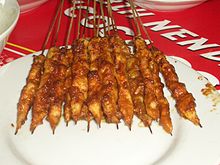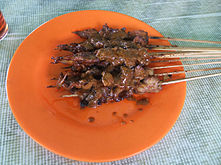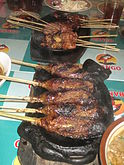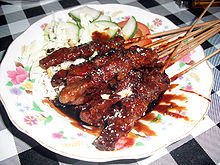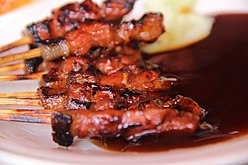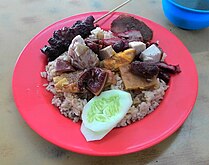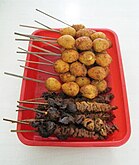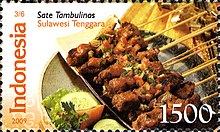Satay
 | |
| Alternative names | Sate, Satai, Satti |
|---|---|
| Course | Entrée or main course |
| Place of origin | Indonesia[1][2][3] |
| Region or state | Java[2] |
| Associatedcuisine | Indonesia,[1] Malaysia,[4][5]Filipino,[6]Singapore,[7][8]andThailand[9] |
| Serving temperature | Hot |
| Main ingredients | Skewered and grilled meats with various sauces, mainly peanut sauce |
| Variations | Numerous variations across Southeast Asia |
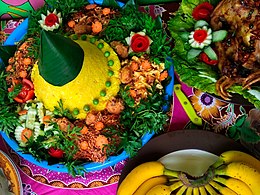 |
| This article is part of the series on |
| Indonesian cuisine Masakan Indonesia |
|---|
|
|
Satay(/ˈsɑːteɪ/SAH-tay,in USA also/ˈsæteɪ/SA-tay), orsateinIndonesian,is aJavanesedish ofseasoned,skeweredandgrilledmeat, served with asauce.The earliest preparations of satay originated inJava,Indonesia.[2][3][10][11][12]but has spread to almost anywhere in Indonesia, where it has become anational dish.[1][13][14][15]Indonesian satay is often served withpeanut sauceandkecap manis– a sweet soy sauce, and is often accompanied withketupatorlontong,a type of rice cake, though the diversity of the country has produced a wide variety of satay recipes. It is also popular in many other Southeast Asian countries including Brunei, Malaysia, Philippines, Singapore and Thailand.[16][17]It also recognized and popular in Suriname and the Netherlands.[18] [19]InSri Lanka,it has become a staple of the local diet as a result of theinfluences from the local Malay community.[20]
Satay may consist of diced or slicedchicken,goat,mutton,beef,pork,fish,other meats, ortofu;bambooskewers are often used, while rustic style of preparations employ skewers from the midrib of thecoconutpalm frond. These aregrilledorbarbecuedover a wood or charcoal fire, then served with various spicy seasonings. Satay can be served in various sauces; however, most often they are served in a combination ofsoyandpeanut sauce.[21]Hence, peanut sauce is often called satay sauce.[22]It is popular asstreet food,[2]and it can be obtained from a travelling satay vendor, from a street-side tent-restaurant, in an upper-class restaurant, or at traditional celebration feasts.
Close analogues areyakitorifrom Japan,kǎoròu chuànfrom China,seekh kebabfrom India,shish kebabfromTurkeyand the Middle East,shashlikfrom theCaucasus,andsosatiefrom South Africa. It is listed at number 14 onWorld's 50 most delicious foodsreaders' poll compiled by CNN Go in 2011.[23]
Origin and history
[edit]Although both Thailand and Malaysia claim it as their own, its Southeast Asian origin was inJava,Indonesia. There satay was developed from the Indian kebab brought by the Muslim traders. Even India cannot claim its origin, for there it was a legacy of Middle Eastern influence.
Jennifer Brennan (1988), Encyclopaedia of Chinese and Oriental Cookery[24]

According to theOxford English Dictionary,the English wordsatayis derived from theMalaywordsatai,[25]alsosatéorsateinIndonesian,ultimately originating fromTamilcatai(சதை,a regional variant oftacaimeaning 'flesh'.[25][26]The term is mentioned assatéinDutchwith one of earliest photographs of satay seller appeared circa 1870 in Java,Dutch East Indies.The usage in English was first attested in 1917 with reference to a "satai"seller inSingapore,later a mention ofsatéinDenpasar,Baliappeared in 1937, with a description of Malays cookingsatayappearing in 1955.[25]Satay may have been developed byJavanesestreet vendors as an adaptation ofkebabsfrom the Indian Subcontinent.[2][17]The introduction of satay, and other now-iconic dishes such astongsengandgulaikambingbased on meats such as goat and lamb, coincided with an influx ofIndianandArabtraders and immigrants starting in the 18th century.[27]The Indonesian publicationKoran Jakartaclaimed thatsate,and ultimately satay, originated from Javanese termsak betengwhich means one stick, and that the dish had existed as early as the 15th century.[28]
From Java, satay spread through theIndonesian Archipelagoand, as a consequence, numerous variations of the dish have been developed. By the late-19th century, satay had crossed theStrait of Malaccainto neighbouringMalaysia,Singapore, andThailand.[29]In the 19th century, the term migrated, presumably with Malay immigrants from the Dutch East Indies, to South Africa, where it is known assosatie.[2]TheIndo Dutch peopletook this dish, as well as many other Indonesian specialties, to the Netherlands, thereby influencingDutch cuisine.[30]
Preparation
[edit]
Satay can be made from various meats.[18]Meat commonly used includes chicken, lamb, goat, mutton, beef,venison,and rabbit; seafood such as fish,shrimp,andsquid;oroffalsuch asliver,intestine, andtripe.Some have also used more exotic varieties of meat, such as turtle,crocodile,horse,lizard,and snake meat. Chicken is most common, but the other meats are frequently used.[31]Satay is made by cutting the meat into small cube shapes, about thumb-size. However, such recipes as Ponorogo use chicken fillet cut into an elongated finger-like shape, thus one skewer holds only one piece. Yogyakarta has a special goat satay called Sate Klatak the difference between other satays is using iron bars for the stick.
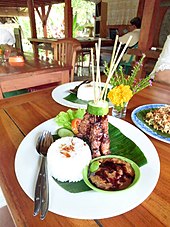
The skewers used for chicken satay are traditionally made fromlidi,a midrib of coconut fronds. Bamboo skewers might be used instead. For firmer meats, such as lamb, goat, and beef, a thicker bamboo skewer is used. The skewers are usually soaked in water before using to avoid burning during grilling. Each skewer usually holds four pieces of meat, some only three pieces. A goat meat satay might insert a cube of fat between meat cubes.Turmericis required to marinate satay to give the dish its characteristic yellow colour. Another popular marinade issweet soy saucemixed with coconut oil or palmmargarine.The skewered meat is seasoned, marinated, and then grilled oncharcoalembers.
Satay may be served with aspicypeanut saucedip, or peanut gravy, served with slices oflontongorketupat(rice cakes), garnished with a sprinkle ofbawang goreng(crisp fried shallot), and accompanied byacar(pickles) consisting of slivers of onions, carrots, andcucumbersin vinegar, salt, and sugar solution. Mutton satay is usually served withkecap manis(sweet soy sauce) instead of peanut sauce. Pork satay can be served in apineapple-based satay sauce or cucumberrelish.
Availability and outlets of note
[edit]
Satay can be prepared home-made or acquired from satay sellers; either from fancy restaurants, modest tarp-tentwarungeateries stationed on busy street side, to travelling food vendors frequenting residential areas. Indeed, satay is possibly one of the most popularstreet foodin Southeast Asia; common in Indonesia to Malaysia and Thailand.


In Indonesia, traditionally there are several methods on selling satay. They are:[32]
- Pikulan:In Indonesian,pikulanmeans carrying items by balancing a rod on one's shoulder. The most traditional way of selling satay was depicted in early photographs of Java in the late 19th century, showing the travelling satay vendor using thispikulanwhich resembles two small wooden cabinets carried with a rod made of either bamboo, wood, or rattan.
- Sunggi:In Javanese,sunggimeans carrying things upon one's head using some kind of tray or platter. This practice is quite common in today's Bali and rural Java. Thesunggisatay vendors — usually women — carry raw satays, lontongs, peanut sauce upon the wooden or wicker bamboo tray on their head, while carrying basket containing grill, charcoal, bamboo fan, sweet soy sauce bottle, and wooden small short chair calleddingklik.The satay seller ladies may walk through residential areas or position their wares in busy areas (e.g. marketplace ortourism area), and grill the satay to their customer's order.
- Gerobak:In Indonesian,gerobakmeans wheeled cart. It is one of the common method of selling satay by travelling vendors. The Madura satay vendor cart usually has unique boat-like shapegerobakfood cart.
- Warung:In Indonesian,warungmeans modest shop, selling foods or other things. The most common sataywarungusually arewarung tenda,modest tarp-tent shop stationed in busy street side to await customers.
- Online satay:In recent years with the advent of digital multi-service method that includes food delivery such asGoFoodandGrabFood,satay is available by ordering online, and the food immediately delivered bymotorcycle taxicalledojek.
In Indonesia, there are some restaurants that specialise in serving various kinds of satay and presenting them as their specialties, such as Sate Ponorogo Restaurant, Sate Blora Restaurant, and also chains of Sate Khas Senayan restaurants, previously known as Satay House Senayan.[33]
Variants
[edit]Indonesia
[edit]
Satay (known assateinIndonesianand pronounced similar to the English "satay" ) is a widely renowned dish in almost all regions of Indonesia; it is considered thenational dishand one of Indonesia's best dishes.[15]Satay is a staple inIndonesian cuisine,served everywhere from street carts to fine dining establishments, as well as in homes and at public gatherings.[34]As a result, many variations have been developed throughout the Indonesian Archipelago. The satay variants in Indonesia is usually named after the region its originated, the meats, parts or ingredients its uses, also might named after the process or method of cooking.[35]
Chicken
[edit]- Sate Ambal
- A satay variant from Ambal,Kebumen,Central Java.This satay uses a native breed of poultry,ayam kampung.The sauce is not based on peanuts, but rather groundtempe,chilli and spices. The chicken meat is marinated for about two hours to make the meat tastier. This satay is accompanied withketupat.
Sate ayam,chicken satay - Sate Asin Pedas
- A salty and spicy chicken, goat and beef satay fromBandunginWest Java.[36]
- Sate Ayam
- Chickensatay, the most common and widely distributed type of satay in Indonesia.
- Sate Ayam Kampung
- Usingayam kampung(free rangechicken) meat.[37]
- Sate Ayam Rebus
- Boiled chicken satay. It has become a side dish ofsoto,[38]mie jawa,ornasi goreng jawa.
- Sate Banjar
- A variant of chicken satay popular inSouthern Kalimantan,especially in the town ofBanjarmasin.
- Sate Blendet
- Chicken satay with yellow sauce from Balong District inPonorogo.The sauce is made of shallots, garlic, candlenuts, coconut milk, and turmeric.[39]
- Sate Blora
- A variant originating inBlora,inCentral Java.This variant is made of chicken (meat and skin) pieces that are smaller compared to the other variants. It is normally eaten with peanut sauce, rice, and a traditional soup made of coconut milk and herbs. Sate Blora is grilled in front of buyers as they are eating. The buyers tell the vendor to stop grilling when they are sated.
- Sate Brutu
- Fleshy part of chicken's tail satay.[40]
- Sate Kulit
- Skin Satay. Found inSumatra,this is a crisp satay made from marinated chicken skin.

- Sate Madura (Madura satay)
- Originating on the island ofMadura,near Java, it is a famous satay variant among Indonesians. Most often made from mutton or chicken, the recipe's main characteristic is the black sauce made fromIndonesian sweet soy sauce/kecap manismixed with palm sugar (calledgula jawaor "Javanese sugar" in Indonesia), garlic, deep fried shallots, peanut paste, petis (a kind ofshrimp paste),kemiri(candlenut), and salt. Chicken Madura satay is usually served in peanut sauce, while the mutton Madura satay is usually served in sweet soy sauce.Sate Madurauses thinner chunks of meat than other variants. It is eaten with rice or rice cakes wrapped in banana/coconut leaves (lontong/ketupat), they are usually sliced into smaller pieces before being served. Raw thinly sliced shallots and plain sambal are often served as condiments.
- Sate Ponorogo (Ponorogo satay)
- A variant of satay originating inPonorogo,a town inEast Java.It is made from sliced marinated chicken meat, and served with a sauce made of peanuts and chili sauce and garnished with shredded shallots,sambal(chili paste) and lime juice. The meat is marinated in spices and sweet soy sauce, in a process calledbacemand is served with rice or lontong (rice cake). The grill is made from terracotta earthenware with a hole in one side to allow ventilation for the coals. After three months of use, the earthenware grill disintegrates, and must be replaced.
- Sate Srepeh
- A variant of chicken satay fromRembang.The satay uses spicy orange sauce and eaten with rice and tofu.[41]
- Sate Taichan
- A spicy chicken satay in hotsambalsauce, served withlontong,popular in Jakarta. It was said that the dish was an adaptation of skewered Chinese snack from Taiwan, which originally uses pork or rabbit meat, and served with soy sauce. The Indonesian version maintain the light Chinese-style seasoning, replaces pork with chicken, and adds spiciness with the addition of hot sambal.[42]Another source mentioned that sate Taichan was devised from a Japanese man's specific request that his satay omits peanut sauce and sweet soy sauce, and only seasoned with a dash of salt and lime juice, and served with chili paste.[43]

Beef
[edit]
- Sate Bumbon
- A spiced beef satay fromKendal,Central Java.It serves with peanut sauce,lontong,boiled bean sprouts, and young jackfruitsayur lodeh.[44]
- Sate Buntel
- Lit: Wrapped Satay, a speciality fromSoloorSurakarta,Central Java.[45]It is made from minced beef, goat,lamb and mutton(especially meats around ribs and belly area). The minced fatty meats are wrapped by thin fat or muscle membrane and wrapped around a bamboo skewer. The size of this satay is quite large, very similar to a Middle Easternkebab.After being grilled on charcoal, the meat is separated from the skewer, cut into bite-size chunks, then served in sweet soy sauce andmerica(pepper).
- Sate Bulayak
- Beef satay with spicy soupy sauce fromLombok.It is eaten with rice cake calledbulayak.[46]
- Sate Gajih
- Beef fat satay popular inYogyakarta,especially inBeringharjoMarket.[47]The fat satay is seasoned with sweet soy sauce and considered as snack since it is commonly served without any rice or additional sauces.
- Sate Jando
- A specialty dish fromBandung,this satay is made from cow's breast fat.[48]
- Sate Kenul
- Cubed beef satay smeared with grated coconut and spices made of turmeric, ginger, cumin, garlic, pepper, salt and coriander. It is a specialty dish fromNganjuk.[49]
- Sate Klopo
- Lit: Coconut Satay, the beef is wrapped in coconut processed spices and then grilled. It is delicacy fromSurabaya.[50]
- Sate Komoh/Komo
- Beef satay fromEast Java.Diced beef is sautéed withbumbubefore grilling.[51][52]
- Sate Kuah
- Lit: Soupy Satay, beef satay served in creamy and spicykuahsoup akin tosoto.Sate kuah can be found inBetawi cuisineof Jakarta and also inPontianak,Western Kalimantan.[53]The Jakarta version sate kuah soup base is akin to Betawi's soto tangkar, since sate kuah was a variant of soto tangkar created in 1960s.[54]Thus usually the seller offers both sate kuah and soto tangkar. The serving method are either grilled beef satay are dipped into soto soup, or the satay meat are stripped from the skewers and put into the soto soup. Compared to soto meat soup, sate kuah has smoky aroma due to grilling process. The Pontianak version sate kuah is smeared with peanut sauce, doused with spiced broth, and sprinkled with spring onion and calamansi juice.[55]
- Sate Lembut
- A rare satay recipe of theBetawi people.It is can be found in Jalan Kebon Kacang,Central Jakarta.The satay is made from minced beef mixed with shredded coconut and spices, wrapped around a flat bamboo skewer. Usually eaten withketupatlaksabetawi(Betawi style Laksa with ketupat glutinous compressed rice).
- Sate Manis
- Also a speciality from theBetawi people.It is also can be found in Jalan Kebon Kacang,Central Jakarta.The satay is made from slices ofhas dalam(tenderloin) the finest part of beef, marinated with sweet spices. Usually eaten withketupatlaksabetawi.

- Sate Maranggi
- Commonly found inPurwakartaandCianjur,the cities inWest Java,this satay is made from beef marinated in a special paste.[56]The two most important elements of the paste arekecombrang(Nicolaia speciosa) flower buds andketan(sweet rice) flour. Nicola buds bring a unique aroma and a liquorice-like taste. The satay is served in sweet soy sauce withacarpickles. It is served with ketan cake (jadah) or plain rice.
- Sate Matang
- A satay variant from Matang Geulumpang Dua,Bireun,Aceh.This satay is made from beef, usually served with peanut sauce andsotoor soup separately.
- Sate Rembiga
- Beef satay fromLombok.The basic seasoning for the satay is chili. However, it is also given some additional spices, such as tamarind, brown sugar, onions, coriander, and candlenut. It is usually eaten with rice cake,plecing kangkung,and beef bone soup.[57]
- Sate Sapi
- Beef satay, served in sweet soy sauce and peanut sauce. Specialty ofJeparatown in Central Java.
- Sate Susu
- Literally it means "milky satay", however it contains no milk, the termsusuis actually refer to cow's breast orudder.This dish that can be found inJavaandBali,is made from grilled spicy beef udder, served with hot chilli sauce.[58]
- Sate Tambulinas
- Spiced beef satay fromSulawesi.Tambulinas satay do not use peanut sauce or soy sauce, it is marinated in spice mixture containing ground chilli pepper, ginger, lemongrass, shallot and garlic, and served with juice of kaffir lime.[59]
Other red meats
[edit]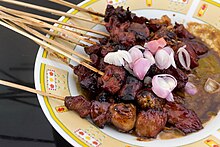
- Sate kambing
- Goat satay, a variant of satay popular inJava,made with goat,lambor mutton meat. Different from other satays,sate kambing(lamb satay) is not usually pre-seasoned or pre-cooked. Raw lamb, mutton, and goat is skewered and grilled directly on the charcoal. It is then served withsweet soy sauce(kecap manis), sliced shallots, and cut-up tomatoes. Since the meat is not pre-cooked, it is important to use young lamb. The best vendors use lamb under three to five months old. Lamb from goat is also more popular than lamb from sheep due to milder flavor.
- Sate kerbau
- Water buffalosatay, a variant of satay popular inKudus,where most Muslim believed that it is forbidden to eat beef to respect the Hindus. This satay is made with water buffalo meat. The meat is cooked first with palm sugar, coriander, cumin, and other seasoning until very tender. Some vendor choose to even grind the meat first to make it really tender. It is then grilled on charcoal, and served with sauce made withcoconut milk,palm sugar, and other seasoning. Traditionally, satay kerbau is served on a plate covered with teak wood leaves.
- Sate klatak/klathak
- Goat satay with coconut milk soup fromBantul Regency,Yogyakarta.[60]
- Sate kronyos
- Breast of goat satay can be found inBantul Regency,Yogyakarta.[61]
- Sate loso
- Water buffalo meat or sometimes replaced with beef satay, served in spicy chili peanut sauce. Specialty ofPemalang,Central Java.[62]
- Sate rusa
- Deer satay, a delicacy fromMerauke,Papua.[63]InEast Kalimantan,a satay dish made ofvenisoncalledsate payau.[64]
- Sate tegal(tegal satay)
- A sate of a yearling or five-month-old lamb; the nickname for this dish in Tegal isbalibul,an acronym ofbaru lima bulan(just five months). Eachkodi,or dish, contains twenty skewers, and each skewer has four chunks — two pieces of meat, one piece of fat and then another piece of meat. It is grilled over wood charcoal until it is cooked between medium and well done; however it is possible to ask for medium rare. Sometimes the fat piece can be replaced with liver or heart or kidney. This is not marinated prior to grilling. On serving, it is accompanied by sweet soya sauce (medium sweetness, slightly thinned with boiled water), sliced fresh chilli, sliced raw shallots (eschalot), quartered green tomatoes, and steamed rice, and is sometimes garnished with fried shallots.
Pork
[edit]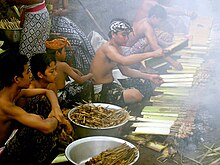
- Sate babi (pork satay)
- Pork satay, popular among theIndonesian Chinesecommunity, most of whom do not share theMuslimprohibition against pork. This dish can be found in Chinatowns in Indonesian cities, especially around Glodok, Pecenongan, and Senen in theJakartaarea. It is also popular inBaliwhere the majority areHindus,it is also popular in Northern Sulawesi, Northern Tapanuli, and Nias, where most people are Christians, and also popular in the Netherlands.
- Sate plecing
- Satay made with variety of grilled meat most often pork, served withsambalplecing, sauce made from chili, garlic, onion, tomatoes, and shrimp paste, popular inBalinese cuisine.
- Sate ragey
- Pork satay popular inMinahasan cuisine.The size is bigger than the common pork satay. It is combined of pork meat and the fat. It can be easily found inTomohon,North Sulawesi.[65]
Fish and seafood
[edit]- Sate Ikan Tuhuk
- Blue marlinSatay, a delicacy fromKrui,Lampung.[66]
- Sate Ikan Pari
- StingraySatay, a satay dish fromTana Tidung Regency,North Kalimantan.[67]
- Sate Bandeng
- MilkfishSatay, fromBanten.It is a satay made from bonelessbandeng(milkfish). The seasoned spicy milkfish meat is separated from the small bones, then placed back into the milkfish skin, clipped by a bamboo stick, and grilled over charcoal.
- Sate Belut
- EelSatay, anotherLombokrare delicacy. It is made frombelut,(lit.eel) commonly found in watery rice paddies in Indonesia. A seasoned eel is skewered and wrapped around each skewer, then grilled over charcoal fire, so each skewer contains an individual small eel.
- Sate Gurita
- Octopussatay, a specialty dish fromSabang.[68]
- Sate Kepiting
- CrabSatay. InLangkat RegencyofNorth Sumatera,the crab's outer shell is removed and the crab is fried in flour mixed withbumbuand then skewered.
- Sate Kerang
- Shellfishsatay,cockleSatay orclamsatay. The most popular variant of sate kerang is fromMedan,North Sumatra,it is rich spicy cooked shellfish in skewer and often becomeoleh-oleh(souvenir) for visitors visiting Medan.[69]In Java, sate kerang it is mildly marinated and boiled, also served as a side-dish to accompany soto. InSoutheast Sulawesi,sate pokeais made ofpokeaclam orBatissa violacea var. celebensisand the satay is smeared with peanut sauce and eaten withburasaorgogos.[70]
- Sate Tanjung
- Fish satay fromLombok.It is made from fish meat which is smeared with spices consisting of coconut milk and spices.[71]The fish used in this satay are usually skipjack tuna and giant trevally.
- Sate Temburung
- Telescope snailSatay, a dish fromNorth Kalimantan.[72]
- Sate Tuna
- TunaSatay, a specialty satay fromGorontalo.[73]

- Sate Udang
- ShrimpSatay that uses large shrimps or prawns,[74]shelled and cleaned and often with the tails off and lightly grilled. Some recipes call for a marinade of thick coconut milk withsambal(chili paste), powderedlaos(galangal root), groundkemiri(candlenut, one can substitute macadamia nuts in a pinch), minced shallots and pressed garlic. One can add salt to taste. Shrimp satay seldom served with the peanut sauce so popular with other satays, because it might overpower a delicate shrimp flavour.
- Sate Ubur-Ubur
- JellyfishSatay. It is a specialty dish from Temajuk Village inSambas Regency,West Kalimantan.[75]
Offals
[edit]- Sate Ampet
- AnotherLombokdelicacy. It is made from beef, cow's intestines and other cow's internal organs. The sauce forsate ampetis hot and spicy, which is no surprise since the island's name,lombok merah,means red chili. The sauce issantan(coconut milk) and spices.[76]
- Sate Babat
- Tripesatay. Mildly marinated and mostly boiled than grilled, usually served as a side-dish to accompanysoto.
- Sate Burung Ayam-ayaman
- Bird Satay, the satay is made from gizzard,liver,andintestinesofburung ayam-ayaman(watercock). After being seasoned with mild spices and stuck on a skewer, this bird's internal organs aren't grilled, but are deep fried in cooking oil instead.
- Sate Hati
- LiverSatay. There is two types of liver satays, cattle liver (goat or cow) and chicken liver satay. The cattle liver made by diced whole liver, while the chicken liver satay is made from mixture of chicken liver,gizzard,andintestines.Usually gizzard is placed on the bottom, intestine on the center and liver or heart on the top. After seasoning, the internal organs are not fried or grilled, but are boiled instead. It's not treated as a main dish, but often as a side dish to accompanybubur ayam(chicken riceporridge).
- Sate Kikil
- Cow skin satay fromJava,this satay is made from boiled cow skin, skewered and seasoned either in spicy peanut sauce or yellow sauce.[77]
- Sate Makassar
- From a region in SouthernSulawesi,this satay is made from beef and cow offal marinated in sourcarambolasauce. It has a unique sour and spicy taste. Unlike most satays, it is served without sauce.

- Sate Padang
- A dish fromPadangand the surrounding area inWestern Sumatra,which is made from cow or goatoffaland meat boiled in spicy broth then grilled. Its main characteristic is a yellow sauce made from rice flour mixed with spicy offal broth, turmeric, ginger, garlic, coriander,galangalroot,cumin,curry powder and salt.[78]It is further separated into two sub-variants, thePariamanand thePadang Panjang,which differ in taste and the composition of their yellow sauces.
- Sate Paru
- Beef lung satay.[79]
- Sate Torpedo
- Testiclessatay. Satay made from goat testicles marinated in soy sauce and grilled. It is eaten with peanut sauce, pickles, and hot white rice.
- Sate Usus
- Chickenintestinesatay. This mildly marinated satay is usually fried, also as a side-dish to accompanybubur ayam.
Mixture
[edit]
- Sate Kalong
- A satay dish fromCirebon.The wordkalong(bat) doesn't mean the satay used bat meat but because the food is sold in the evening. This satay is made from minced water buffalo, which is mixed with spices, and palm sugar and dipped into buffalo broth, it is then grilled on charcoal. The peanut sauce mixed withoncom.[80]
- Sate Lilit
- A satay variant fromBalinese cuisine.This satay is made from minced pork, chicken, fish, beef, or even turtle meat, which is then mixed with grated coconut, thick coconut milk, lemon juice, shallots, and pepper. Wound around bamboo, sugar cane or lemon grass sticks, it is then grilled on charcoal.[81]
- Sate Pusut
- A delicacy fromLombok,the neighbouring island east ofBali.It is made from a mixture of minced meat (beef, chicken, or fish), shreddedcoconutmeat, and spices. The mixture then is wrapped around a skewer and grilled over charcoal.
Eggs and vegetarian
[edit]- Sate Aci
- The satay is made fromtapiocastarch batter.[82]
- Sate Jengkol
- Jengkolsatay.[83]
- Sate Jamur
- Mushroom satay. It is usually made fromoyster mushroom.[84]
- Sate Kere
- Lit: Poorman's satay. A cheap vegetarian satay made from groundedtempefromSolocity, served in peanut sauce and pickles. There are two kinds oftempe:the most popular is made from soybean, and the second is made from the side product material of tofu production (calledtempe gembus). Sate Kere is usually made fromtempe gembus.The wordkerein theJavanese languagemeans "poor"; it originally was meant to provide the poor people of Java with the taste of satay at an affordable price, since meat was considered a luxury. Although originally it was only vegetarian tempeh, today,sate kerealso includes intestine, liver, and beef satays mixed with tempeh ones. The materials are pre-cooked inbacemanbefore being grilled, then served with peanut sauce.
- Sate Pencok
- The satay fromLombokis made fromsagostarch. It is smeared withpelalahsauce.[85]
- Sate Tahu
- Lit: Tofu Satay. A specialty fromPonorogo.Tofu is soaked first withbacemseasoning before being grilled on a clay kiln.[86]
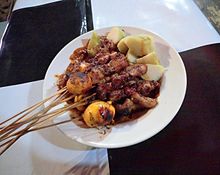
- Sate Telur Muda
- Young egg satay. This satay is made from premature chicken egg (uritan) obtained upon slaughtering the hens. The immature eggs that have not developed theeggshellyet are boiled and put onto skewers to be grilled as satay. Thetelur mudaoruritanis often cooked on the same skewer as chicken skin satay, and mixed with chicken satay. This kind of satay is also usually served as a side dish to accompanybubur ayam.
- Sate Telur Puyuh
- Quail eggssatay. Several hard-boiled quail eggs are put into skewers, marinated in sweet soy sauce with spices, and boiled further also served as a side dish for soto.
Others
[edit]- Sate Bebek
- Duck satay, a specialty dish fromCilegon,Banten[87]andBanyumas.[88]
- Sate Blengong
- The satay is made fromBlengongmeat, an animal that is the result of crossbreeding between ducks andmuscovy ducksor locals calledmenthok.It is a delicacy ofBrebes.[89]
- Sate Bulus
- Turtle satay, another rare delicacy fromYogyakarta.It is a satay made from freshwaterbulus(softshell turtle). It is served with sliced fresh shallots (small red onion), pepper, and sweet soy sauce. Bulus meat is also served in soup ortongseng(Javanese style spicy-sweet soup).
- Sate Kelinci
- Rabbit meat Satay, this variant of satay is made from rabbit meat, a delicacy fromJava.It is served with sliced fresh shallots (small red onion), peanut sauce, and sweet soy sauce. Rabbit satay usually can be found in mountainous tourist region in Java where locals breed rabbit for its meat, such asLembanginWest Java,KaliuranginYogyakarta,Bandungan and Tawangmangu resort inCentral Java,also Telaga Sarangan inEast Java.

- Sate Keong
- Freshwater snail Satay.[90]This kind of satay is also served as a side dish ofpecel.InMinahasan cuisine,sate keongis grilled and smeared with spicy sambal and it is calledsate kolombi.[91]
- Sate Kuda
- Horse meat Satay. Locally known in Javanese assate jaran,this is made from horse meat, a delicacy fromYogyakarta.It is served with sliced fresh shallots (small red onion), pepper, and sweet soy sauce.
- Sate Ular
- Snake Satay, a rare and exotic delicacy usually founds in foodstalls specialise on serving exotic reptile meats like snakes andbiawak(monitor lizards), such as the one founds near Gubeng train station inSurabaya,or near Mangga Besar and Tebet train station in Jakarta. It usually usesular sendok(cobra) orsanca(python) meat. It is served with sliced fresh shallots (small red onion), pickles, pepper, and sweet soy sauce.
- Sate Ulat Sagu
- Sago caterpillar satay fromPapua,[92]Kalimantan,andSulawesi.
-
Sate Blora
-
Sate Banjar
-
Goat liver satay
-
Sate Padangwith yellow sauce
-
Sate buntel,Solo, Central Java
-
Sate sapi,beef satay from Jepara
-
Sate srepehfrom Rembang, Central Java
-
Horse satay,Yogyakarta
-
Balinesesate plecing,pork satay
-
Balinese pork satay
-
Sate Bulayak Suranadi,Lombok
-
Sate kikil
-
Indonesian Chinesenasi campurwith pork satay
-
Quail eggs and intestine satays
-
Soto with tripes and cockles satays
-
Sago grubsatay
Malaysia
[edit]This sectionneeds additional citations forverification.(May 2017) |

Known assatein Malay[93](and pronounced similarly to the English "satay" ), it can be found throughout all the states of Malaysia in restaurants and on the street, with hawkers selling satay in food courts andPasar malam.While the popular kinds of satay are usually beef and chicken satays, different regions of Malaysia have developed their own unique variations. Sate is often associated with Muslim Malays, but pork sate is also available at non-halal Chinese eating establishments.
There are a number of well-known satay outlets inKajang,a city in Selangor closely associated with satays.[94]Sate Kajangis a generic name for a style of sate where the meat chunks are bigger than normal, and the sweet peanut sauce served along with a portion of fried chilli paste. Given its popularity, sate Kajang is now found throughout Malaysia. Stalls and restaurants around Kajang offer not only the more traditional chicken or beef satay, but also more exotic meats such as venison, rabbit or fish, as well as gizzard, liver, and a number of other variations.
Another type of meat satay is thesate lok-lokfromPenangandsate celup(dip satay) fromMalacca.Both are Malaysian Chinese fusions of the hotpot and the Malay satay. Pieces of raw meat, tofu, century eggs, quail eggs, fish cake, offal or vegetables are skewered on bamboo sticks. These are cooked by being dipped in boiling water or stock. The satay is then eaten with a sweet, dark sauce, sometimes with chilli sauce as an accompaniment. If the satay is eaten with satay sauce, it is called sate lok-lok. If the satay is cooked with boiling satay peanut sauce, it is called sate celup. Both dishes are available from street vendors or in certain restaurants, and the majority are not halal. Customers use a common container containing boiling stock to personally cook their satay. Sauces are either served in common containers or individually. There are usually no tables near street vendors, and customers thus tend to gather around the food cart.
Satay gula apong is a chicken or buffalo meat satay. It is a satay made with rare nipah palm sugar called sarawak gula apong. This rare satay can only be found in Linggi, Negeri Sembilan in Malaysia. It is served with sliced fresh cucumber and peanut sauce.
Netherlands
[edit]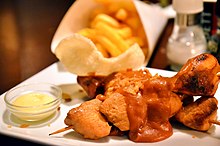
Known assatéorsateh,it is fully adapted in Dutch everyday cuisine. Owed to their shared colonial history, satay is an Indonesian food that has become an integral part of Dutch cuisine.[95]Pork and chicken satays are almost solely served with spicy peanut sauce and calledeen sateetje,and are readily available in snackbars and supermarkets.[96]Versions with goat-meat (sateh kambing) and sweet soy sauce are available in Indonesian restaurants and take-aways. Pork or chicken satay in peanut sauce, with salad and French-fries, is popular in pubs oreetcafés.With Indonesian take-away meals likenasi goreng speciaal,the special part is often a couple of sate-sticks. Another favourite in Dutch snackbars is thesatékroket,acroquettemade with a peanut sauce and shredded meatragout.In addition, 'saté' sauce or peanut sauce has become one of the standard options as a condiment to accompany a portion of fries bought in a snackbar (besidesmayonnaise,ketchup,curry-ketchup,'joppiesaus' or a combination). Fries with satay sauce is commonly known aspatatje pinda('fries peanut') and fries with satay sauce, mayonaise and chopped unions is calledpatatje oorlog('fries war').
Philippines
[edit]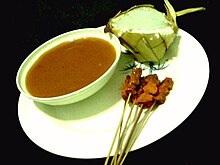
Satay proper is known assattiin the Southern Philippines (Mindanao). It is common in the regions ofZamboanga,Sulu ArchipelagoandTawi-Tawi,which acquired satay from its proximity toMalaysia.[97]Sattiusually only has three small strips of roasted meat on a stick.Sattiis usually made from chicken or beef amongMuslim Filipinos,[98]but it can also be made with pork or liver.[99]It is particularly popular inTausugcuisine and is commonly eaten as breakfast in restaurants which specialise insatti.It is typically served withta'mu(pusôin other Philippine languages) and a bowlful of warm peanut-based sauce.[100]
In the majority of the Philippines, a similar (but native) dish to satay usually made with pork or chicken is referred to asinihaworinasal,or by the generic English name "barbecue" (usually shortened to "BBQ" ).[101][98][102]It is usually served glazed in a sweet-soy sauce marinade reminiscent ofyakitori.Despite the native origins of inasal and inihaw, the English association of "barbecue" is the source of names for other popular street foods that are also served skewered, such asbanana cue( "banana" + "barbecue" ) andcamote cue( "camote(sweet potato) + barbecue ").[103]
Offal-based versions of inihaw are also commonly sold in the Philippines as street food. The most popular are made from chicken or pork intestines known asisaw.Other variants use liver,tripe,lungs, chicken heads and feet,cubes of coagulated pork blood,and pork ears, among others.[104][105]
Annatto seedsandbanana ketchup-based sauces are also widely used which gives the meat a vibrant orange or red color.[100][106]
Singapore
[edit]
In Singapore, satay is sold by Chinese, Malay and Indian Muslim vendors. It is thought to have originated in Java and brought to Singapore by Muslim traders.[107]Satay is one of the earliest foods that became ubiquitous in Singapore since the 1940s, and was considered a celebratory food.[108]Previously sold on makeshift roadside stalls and pushcarts, concerns over public health and the rapid development of the city led to a major consolidation of satay stalls atBeach Roadin the 1950s, which came to be collectively called the "Satay Club".They were moved to the Esplanade Park in the 1960s, where they grew to the point of being constantly listed in tourism guides.
Open only after dark with an open air or "al fresco" dining concept, the Satay Club defined how satay is served in Singapore since then, although they are also found across the island in most hawker stalls, modern food courts, and upscale restaurants at any time of the day. Moved several times around Esplanade Park due to development and land reclamation, the outlets finally left the area permanently toClarke Quayin the late 1990s to make way for the building of theEsplanade - Theatres on the Bay.[108]
Several competing satay hotspots have since emerged. While the name has been transferred to the Clarke Quay site, several stalls from the original Satay club have moved toSembawangin the north of the city. The satay stalls at theLau Pa Satarea are notable for its popularity. "Satay Street" inBoon Tat Street,introduced in 1996, centers around 10 hawkers who sell satay. Served only at night after 7pm when the street is closed to vehicular traffic and the stalls and tables occupy the street, it mimics the open-air dining style of previous establishments. It is said to evoke the nostalgic feeling of Singaporean street food culture from the 1950s and 1960s, and is considered to be the last Satay Club in Singapore.[108]Other notable outlets include Satay by the Bay at theGardens by the Baytourist attraction. It is styled after the old Satay Club.[109]
Peanut sauce is used in Singaporean satays, Malay satay is quite similar to Indonesian satay by usingkecap manis(sweet soy sauce), while Chinese Hainan satay uses pineapplepuréesauce and marinated infive-spice powder.[107]The common types of satay sold in Singapore includeSatay Ayam(chicken satay),Satay Lembu(beef satay),Satay Kambing(muttonsatay),Satay Perut(beef intestine), andSatay Babat(beef tripe).
Singapore's national carrier,Singapore Airlines,also serves satay to itsFirstand Business Class (previously known as Raffles Class) passengers as anappetiser.
Sri Lanka
[edit]Satheas it is known in Sri Lanka is aSri Lankan Malaydish that has become a staple of the country's diet.[20]Satheis served with peanut and chili sauce.[20]It is sometimes calledsate dagingby the country's Malay community.[110]
Thailand
[edit]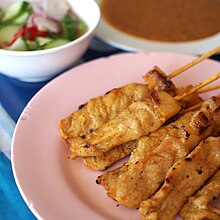
Satay (Thai:สะเต๊ะ,RTGS:sate,pronounced[sā.téʔ]) is a popular dish in Thailand; a key feature of Thai satay is the inclusion of pork as a meat option.[111]Usually served with peanut sauce andachat,Thai satay have various recipes, beyond the popular versions of chicken, beef, and pork: a version made with mussels is calledhoi malaeng phu,while vegetarian variants employ soy protein strips or tofu.[112]
Satay can easily be found in virtually any Thai restaurant worldwide. BecauseThai cuisineis heavily marketed internationally and attracted world culinary attention earlier than other Southeast Asian cuisines, there is a widespread misconception abroad that satay originated from Thailand. As a result, it is most frequently associated with Thai food in the Western world.[113]For example, in the United States, satay is said to be one of America's favourite Thai dishes.[114]
The first satay restaurant in Thailand was in front of Chaloem Buri Theater near theChaloem Buri Intersectionin theYaowaratneighborhood.Now it is onRama IV RoadnearLumphini MRT stationand has been for more than 50 years.[115]
Fusion satay
[edit]
Traditionally, satay referred to any grilled skewered meats with various sauces; it is not necessarily served solely with peanut sauce. However, since the most popular variant of satay is chicken satay in peanut sauce (Sate Madurain Indonesia), in modernfusion cuisinethe term "satay" has shifted to satay style peanut sauce instead.[10]
For example, the fusion "satay burger" refers tobeef hamburgerserved with so-called "satay sauce", which is mainly a kind of sweet and spicy peanut sauce or often replaced with gloppypeanut butter.[116][117]The Singaporesatay bee hoonis actually rice vermicelli served in peanut sauce. The American-Thai fusion fish fillet in satay sauce also demonstrates the same trend. The fusionFrench cuisineCuisses de Grenouilles Poelees au Satay, Chou-fleur Croquantis actuallyfrog legsin peanut sauce.[118]TheIndomieinstant noodleis also available in satay flavour, which is only the addition of peanut sauce in its packet.[119][120]In Hong Kong, satay sauce is usually served withinstant noodlesand stir-fried beef. This dish is most often eaten for breakfast.[121]
Satay in culture
[edit]Being for a very long time one of the most popular dishes of the national cuisines of Indonesia, satay has taken a fairly prominent place in the culture of these countries. In bothIndonesian,the verbmenyate(to cook satay) arose, based on the corresponding root stem. In addition to its direct meaning, it also has a figurative meaning —to bring discord,to separate,and the corresponding nounpersateanmeansdiscord, split, troubles,which is associated with one of the main stages in the preparation of this dish — cutting the product into pieces.[citation needed]
The termpersateanis often contrasted with similar sounding termpersatuan(unity), to contradict their meanings. The contrastingword playsentence:"Persatuan bukan persatean"was famously emphasised byMohammad Hattathat uses satay as ametaphor.During his speech, Hatta denotes thatpersatean— the "unity" among meat pieces in satay — is "forced" upon them by stabbing them with skewer, thus eloquently argue that this type of "satay unity" is not desired, since it is forced upon, not genuine and without the willingness of those who participates.[122]
Satay belongs to the informal ethnocultural symbols of Indonesia. The image of this food appears on Indonesian postage stamps, in tourist brochures, information and advertising materials dedicated to this country, and is often played up by Indonesian participants in various cultural and entertainment events held abroad to create a national flavor. For example, the Indonesian model Aurra Kharisma performed in 2021 at theMiss Grand Internationalbeauty pageant in a suit with satay images and a headdress decorated with several bundles of satay meat skewers.[123] [124] [125]
In some parts of Indonesia, certain types of satay are attributed with different symbolic meanings. EspeciallyBalistands out: the popular on this islandsatay lilit— minced sausages stuck on lemongrass stalks — is considered there a symbol of several virtues and benefits at once: male prowess, unity and prosperity.[126]The Balinese attribute the embodiment of the weapons of variousHindu deitiesand mythological heroes to other local types of satay.[127]
InBandung,theWest JavaGovernor's office is popularly calledGedung Sate(Indonesian:Satay building) to refer the satay-like pinnacle on its roof.[128]
See also
[edit]- Brochette– Thin metal or wood stick used to hold pieces of food together
- Satay building– Public building in West Java, Indonesia
- List of chicken dishes– Foods prepared with chicken
- Pinchitos– Southern Spain skewered meat dish
- Shacha sauce,also known as Sate-sauce – Chinese condiment
- Yakitori– Japanese type of grilled chicken
 Food portal
Food portal
References
[edit]- ^abcSara Schonhardt (25 February 2016)."40 Indonesian foods we can't live without".CNN International.Hong Kong:Warner Bros. Discovery.Archivedfrom the original on 6 April 2017.Retrieved13 April2017.
- ^abcdefBruce Kraig; Colleen Taylor Sen Ph.D. (9 September 2013).Street Food around the World: An Encyclopedia of Food and Culture: An Encyclopedia of Food and Culture.ABC-CLIO. p. 183.ISBN978-1-59884-955-4.
- ^abO'Neill, Molly (2 July 2000)."Food; The Stick Shift".The New York Times.ISSN0362-4331.Archivedfrom the original on 3 July 2020.Retrieved13 April2020.
- ^Michael Specter (2 December 1984)."IN MALAYSIA, SPICY SATAY".The New York Times.Archivedfrom the original on 26 December 2018.Retrieved27 August2020.
- ^Shalini Ravindran (28 June 2018)."Five places for great satay".The Star.Archivedfrom the original on 8 October 2020.Retrieved27 August2020.
- ^"Satti: A spicy delicacy for breakfast".2 September 2019.
- ^"So much more to satay than peanut sauce".Food.Archivedfrom the original on 21 August 2018.Retrieved21 August2018.
- ^Eliot, Joshua (1994).Indonesia, Malaysia & Singapore Handbook.New York: Trade & Travel Publications. p. 352.
- ^Erickson, Joan (1982).Southeast Asia Sunset travel guides.Lane Publishing Company. p. 78.ISBN978-037-606-764-7.
- ^ab"Consumers love succulent Satay, Peanut ingredients for global success"(PDF).USA Peanuts. p. 1. Archived fromthe original(PDF)on 2 May 2014.Retrieved2 May2014.
- ^Felicity Cloake (30 January 2014)."How to cook the perfect chicken satay".The Guardian.Archivedfrom the original on 14 July 2014.Retrieved7 July2014.
- ^"Satay Washington DC".satay.com.Archivedfrom the original on 9 January 2019.Retrieved6 July2014.
- ^Media, Kompas Cyber."Kemenpar Tetapkan 5 Makanan Nasional Indonesia, Ini Daftarnya".KOMPAS.com(in Indonesian).Archivedfrom the original on 18 April 2018.Retrieved18 April2018.
- ^Owen, Sri (1999).Indonesian Regional Food and Cookery.ISBN9780711212732.Archivedfrom the original on 9 October 2013.Retrieved7 July2010.
- ^abSara Schonhardt and Melanie Wood (15 August 2011)."40 of Indonesia's best dishes".CNN.Archivedfrom the original on 26 December 2018.Retrieved6 July2014.
- ^"Grilled Beef Satay".Food Reference.com.Archivedfrom the original on 15 August 2010.Retrieved6 July2010.
- ^abAlan, Davidson (2006).The Oxford Companion to Food(2nd ed.). Oxford: OUP.ISBN9780191018251.OCLC862049879.
- ^abadmin (11 December 2013)."What is Satay Food and Its Origin".Satay Ria.Archivedfrom the original on 7 June 2020.Retrieved7 June2020.
- ^"So much more to satay than peanut sauce".Food.Archivedfrom the original on 21 August 2018.Retrieved21 August2018.
- ^abcBullis, Douglas; Hutton, Wendy (2001).Food of Sri Lanka.Periplus.p.14.
- ^Marx, Pamela (1996).The Travel-the-world Cookbook.Good Year Books. p.30.ISBN9780673362544.
indonesian satay peanut sauce.
- ^"Peanut butter and satay sauce – recipe".The Guardian.Archivedfrom the original on 8 February 2017.Retrieved7 February2017.
- ^CNN Go[1]Archived11 November 2012 at theWayback MachineYour pick: World's 50 most delicious foods, 7 September 2011. Retrieved 11 October 2011
- ^Alan, Davidson (2006).The Oxford Companion to Food(2nd ed.). Oxford: OUP.ISBN9780191018251.OCLC862049879.
- ^abc"satay, n."Oxford English Dictionary.Archivedfrom the original on 7 June 2020.Retrieved19 January2020.
- ^SatayArchived18 June 2012 at theWayback Machine,The Free Dictionary
- ^Christina Andhika Setyanti (30 August 2016)."Sepotong Sejarah Autentik Indonesia dalam Semangkuk Tongseng"(in Indonesian). CNN.Archivedfrom the original on 31 August 2016.Retrieved31 August2016.
- ^"Beda Daerah, Beda Sajian Sate".Koran Jakarta(in Indonesian). 25 September 2019. Archived fromthe originalon 26 September 2019.Retrieved24 March2021.
- ^David Joachim; Andrew Schloss (2010).Mastering the Grill: The Owner's Manual for Outdoor Cooking.Chronicle Books. p. 116.ISBN9780811878357.Archivedfrom the original on 13 June 2020.Retrieved9 June2020.
- ^Engelbrecht, Karin."A Look at Culinary Influences on the Dutch Kitchen – How Other Cuisines Influenced the Dutch Kitchen Throughout History".About Food.Archivedfrom the original on 5 October 2011.Retrieved20 April2016.
- ^"Delicious Satay, Indonesia's Most Famous Dish! - Indonesia Travel".www.indonesia.travel.Retrieved30 November2022.
- ^"Di Sini Sate, Di Sana Sate".Kompas.id Tutur Visual(in Indonesian). 10 November 2021.Retrieved11 November2021.
- ^Media, Kompas Cyber (14 February 2009)."Sate Khas Senayan Tidak Sekadar Jualan Sate".Archivedfrom the original on 23 March 2012.Retrieved3 September2011.
- ^"Satay Junction, Indonesian Cuisine".Satay Junction.Archivedfrom the original on 12 June 2010.Retrieved6 July2010.
- ^"Sataysfying Sataysfaction".My Cooking Without Borders.19 May 2011.Archivedfrom the original on 8 September 2011.Retrieved15 January2015.
- ^Mediatama, Grahanusa (3 January 2022)."5 Sate Asin Pedas Terenak di Bandung, Enak dan Pedasnya Nampol".PT. Kontan Grahanusa Mediatama(in Indonesian).Retrieved4 May2023.
- ^"Sate Podomoro, Jagonya Sate Ayam Kampung".makanjogja.com(in Indonesian).Retrieved5 April2023.
- ^"Sate Ayam Rebus Ala Warung Soto".diahdidi.com(in Indonesian).Retrieved28 April2023.
- ^Pebrianti, Charolin."Sate Blendet Bersaus Rempah yang Gurih Wangi dari Ponorogo".detik.com(in Indonesian).Retrieved4 April2023.
- ^Afriadi, Abednago."Resep Sate Brutu Ayam".pikiran-rakyat.com(in Indonesian).Retrieved28 April2023.
- ^Naufal, Mazka Hauzan."Mencicipi Rasa Unik Sate Srepeh Kuliner Khas Rembang, Sate Ayam dengan Kuah Santan Berwarna Oranye".tribunnews.com(in Indonesian).Retrieved4 April2023.
- ^"Introducing 'sate taichan,' Jakarta's popular spicy satay dish".The Jakarta Post.26 December 2016.Archivedfrom the original on 16 January 2017.Retrieved16 January2017.
- ^"How a Japanese man gave Indonesian satay a twist".The Jakarta Post.17 February 2017.Archivedfrom the original on 6 August 2017.Retrieved26 July2017.
- ^"Sate Bumbon".jatengprov.go.id(in Indonesian). Central Java Government.Retrieved11 August2022.
- ^"Sate buntel, makanan kesukaan Jokowi"(in Indonesian). BBC Indonesia. 20 October 2014.Archivedfrom the original on 23 October 2017.Retrieved22 October2017.
- ^"Sate Bulayak, Kuliner Lombok Barat Yang Menggoda".lombokbaratkab.go.id(in Indonesian). Government of Lombok Barat Regency. 12 April 2012.Retrieved4 April2023.
- ^"Sate Gajih Enak dan Lezat Bikin Nagih".MALIOBORO NEWS(in Indonesian). 14 December 2020.Retrieved4 December2021.
- ^"Sate Jando".tribunnews(in Indonesian). 15 June 2021.Retrieved18 July2022.
- ^Nandiastuti, Septi; Febriani, Rizky Tyas."Sate Kenul, Kuliner Legendaris Khas Nganjuk yang Sering Diburu Wisatawan Saat Ramadan".tribunnews.com(in Indonesian).Retrieved7 January2024.
- ^"Cobain Sate Klopo Khas Surabaya".kompas.com(in Indonesian).Retrieved4 April2023.
- ^Agmasari, Silvita (15 March 2021)."Resep Sate Komoh, Sate Daging Sapi Khas Jawa Timur".kompas.com(in Indonesian).Retrieved28 April2023.
- ^Marks, Copeland."Sate Komo".The New York Times.Retrieved28 April2023.
- ^"Sate Kuah Rempah Pontianak".rasasayange.co.id(in Indonesian).Archivedfrom the original on 20 February 2020.Retrieved12 September2020.
- ^Kustiani, Rini (17 March 2019)."Makan Sate tapi Pakai Kuah, Coba Sate Kuah Pak Haji Diding".Tempo(in Indonesian).Archivedfrom the original on 11 November 2020.Retrieved12 September2020.
- ^Chaniago, Suci Wulandari Putri; Agmasari, Silvita (2 November 2022)."Mengulik Sate Kuah Pontianak, Kuliner Khas Kalimantan Barat".kompas.com(in Indonesian).Retrieved4 April2023.
- ^"Sate Maranggi – Purwakarta Beef Satay – Daily Cooking Quest".Daily Cooking Quest.5 October 2015.Archivedfrom the original on 28 October 2017.Retrieved22 October2017.
- ^Sabandar, Switzy (20 September 2022)."5 Tempat Makan Sate Rambiga Terenak di Lombok".liputan6.com(in Indonesian).Retrieved4 April2023.
- ^"Sate Susu ala Bali".KOMPAS.com(in Indonesian). Archived fromthe originalon 29 June 2016.Retrieved22 October2017.
- ^Pratiwi, Yunia (30 July 2020)."Bosan Olahan Sate yang Biasa, Coba Resep Sate Tambulinas untuk Daging Kurban".Tempo.co(in Indonesian).Retrieved27 April2022.
- ^W, Yoseph Hary."Tujuh Sate Klatak Enak dan Terkenal di Pleret Bantul".tribunnews.com(in Indonesian). Tribun Jogja.Retrieved4 April2023.
- ^Purwoko, Trisna; Ramadhan, Muarif (22 May 2021)."Berburu kuliner unik sate kronyos di Bantul".inews.id(in Indonesian).Retrieved8 December2022.
- ^"Enak dan Gurihnya Sate Loso Khas Pemalang".KOMPAS.tv(in Indonesian). 1 June 2020.Retrieved28 April2022.
- ^Gassing, Ipul (31 July 2015)."Mencoba Daging Rusa di Merauke".indonesiana.id(in Indonesian).Retrieved11 August2022.
- ^R, P Suryo (25 September 2018)."Sate Payau, Kuliner Paling Langka di Kalimantan Timur".merahputih.com(in Indonesian).Retrieved28 April2023.
- ^"Ragey, Sate Ukuran Jumbo Khas Sulawesi Utara".indonesiakaya.com(in Indonesian).Retrieved4 April2023.
- ^Media, Kompas Cyber."Promosi Lewat Ikan Tuhuk".KOMPAS.com(in Indonesian).Archivedfrom the original on 26 April 2018.Retrieved26 April2018.
- ^"Sate Ikan Pari".pens.ac.id(in Indonesian).Retrieved28 April2023.
- ^"Gurihnya Sate Gurita Khas Sabang".Indonesiakaya.com(in Indonesian).Retrieved7 September2022.
- ^"Sate Kerang Istimewa Rahmat".Medan Magazine(in Indonesian). 27 March 2012. Archived fromthe originalon 29 March 2012.Retrieved22 June2012.
- ^Alsair, Ach Hidayat."Lezatnya Sate Pokea, Kuliner Khas Sultra Terbuat dari Bahan Kerang".idntimes.com(in Indonesian).Retrieved26 April2023.
- ^Anis, Anis."Resep Sate Tanjung".idntimes.com(in Indonesian).Retrieved4 April2023.
- ^Hidayat, Marifka Wahyu (23 February 2023)."Mirip Kerang, Inilah Sate Temburung Makanan Khas Kalimantan Utara".liputan6.com(in Indonesian).Retrieved28 April2023.
- ^Wijaya, Mas Ardy (25 September 2017)."Sate Tuna".budaya-indonesia.org(in Indonesian).Retrieved18 July2022.
- ^"Satay prawns".The Australian Women's Weekly.Sydney:Are MediaPty Limited.Archivedfrom the original on 4 August 2016.Retrieved15 June2016.
- ^"Sate Ubur-Ubur".kemenparekraf.go.id(in Indonesian). Indonesia Ministry of Tourism.Retrieved4 June2023.
- ^"Sate Ampet/Sate Bulayak Lombok"(in Indonesian).Archivedfrom the original on 14 January 2018.Retrieved13 January2018.
- ^"30 resep sate kikil enak dan sederhana".Cookpad(in Indonesian).Archivedfrom the original on 14 January 2018.Retrieved13 January2018.
- ^"Where to find a mouth-watering 'sate Padang' dinner in South Jakarta".The Jakarta Post.Archivedfrom the original on 14 January 2018.Retrieved13 January2018.
- ^Hutajulu, Sabrina Tio Dora."Resep Sate Paru Goreng".tribunnews.com(in Indonesian).Retrieved28 April2023.
- ^"Sate Kalong, Sajian Khas Cirebon yang Hanya Muncul Pada Malam Hari".kumparan.com(in Indonesian). kumparanfood. 20 June 2018.Retrieved14 August2022.
- ^Kitchen, Esensi's.THE SATAY.Esensi.Archivedfrom the original on 9 June 2020.Retrieved19 August2019.
- ^Pinjungwati, Gayuh Tri (2 September 2020)."Resep Sate Aci Sambal Kacang".fimela.com(in Indonesian).Retrieved14 August2022.
- ^Rs, Sukmawati; Chaerunnisa, Chaerunnisa."Resep Sate Jengkol, Mantap!".suara.com(in Indonesian).Retrieved28 April2023.
- ^Setyorini, Tantri (28 November 2019)."3 Resep Sate Jamur Tiram".merdeka.com(in Indonesian).Retrieved20 July2022.
- ^Burama, Feri (20 October 2022)."Ke Lombok? Jangan lupa mampir di Kuliner Khasnya Ya Ada Sate Pencok".jabarekspres.com(in Indonesian). Radar Garut.Retrieved4 April2023.
- ^Dedi, Dedi."Nikmati Kelezatan Sate Tahu Ponorogo yang Berbeda dari yang Lain".suara.com(in Indonesian).Retrieved5 April2023.
- ^Karim, Fikri Abdul (14 October 2019)."Sate Bebek Dari Cilegon".GNFI(in Indonesian).Retrieved14 August2022.
- ^Jatmiko, Sonik (24 February 2022)."Sate Bebek Tambak".tvonenews.com(in Indonesian).Retrieved14 August2022.
- ^Sabrina, Julie (26 March 2022)."Kelezatan Sate Blengong, Kuliner Khas yang Hanya Ada di Brebes".liputan6.com(in Indonesian).Retrieved14 August2022.
- ^"Sate Keong".detik.com(in Indonesian). Detik.Retrieved11 August2022.
- ^Irham, Muhammad."Lezatnya Sate Kolombi, Kuliner Khas Minahasa yang Tiada Duanya".tribunnews.com(in Indonesian).Retrieved26 February2023.
- ^Rasi, Azizah."Sate Ulat Sagu".pens.ac.id(in Indonesian).Retrieved28 April2023.
- ^Munan, H. (2008).CultureShock! Malaysia: A Survival Guide to Customs and Etiquette.Culture shock!. Marshall Cavendish International (Asia) Ptd Limited. p. 154.ISBN978-981-4408-95-0.Archivedfrom the original on 19 August 2020.Retrieved10 May2017.
- ^Khoo, Ethel; Chan, E. Jacqui (2019)."Kajang: More Growth Ahead".The Edge Markets.Retrieved22 December2022.
- ^"Top 10 Dutch foods – with recipes".Retrieved27 June2022.
- ^Frommer'sIrreverent Guide to Amsterdam, 2004, p 66
- ^"Travel Gastronomy: Satti Ala Zambo ~ Boarding Gate 101".30 January 2013.Archivedfrom the original on 17 December 2014.Retrieved15 January2015.
- ^abJimenez, Gidget (2015).All About the Philippines: Stories, Songs, Crafts and Games for Kids.Tuttle Publishing. p. 59.ISBN9781462917259.Archivedfrom the original on 9 June 2020.Retrieved5 September2016.
- ^"Satti in the city and more".Ironwulf.net. 7 August 2007.Retrieved12 February2019.
- ^ab"Unique Flavors of Western Mindanao: Satti".Archivedfrom the original on 17 December 2014.Retrieved15 January2015.
- ^Ellen Brown (14 June 2016)."Smart Cooking: Philippine cuisine shaped by many influences".Providence Journal.Archivedfrom the original on 8 February 2017.Retrieved8 February2017.
- ^Raichlen, Steven (24 April 2013)."Filipino Satti".Barbeuce! Bible.Archivedfrom the original on 2 January 2017.Retrieved5 September2016.
- ^Overseas Pinoy Cooking.NetArchived3 March 2016 at theWayback Machinewebsite. Retrieved 6 November 2010
- ^"Isaw ng Manok (Grilled Chicken Intestine)".Panlasang Pinoy.27 February 2009.Archivedfrom the original on 16 September 2016.Retrieved6 September2016.
- ^"Isaw and other Pinoy Street Barbecue".Ang Sarap.7 March 2014.Archivedfrom the original on 12 April 2016.Retrieved6 September2016.
- ^Edgar Soon (2009).Pairing Wine with Asian Food.Monsoon Books.ISBN9789814358941.Archivedfrom the original on 9 June 2020.Retrieved9 June2020.
- ^abPolytechnic, Temasek (15 July 2015).Singapore Hawker Classics Unveiled: Decoding 25 Favourite Dishes.Marshall Cavendish International Asia Pte Ltd.ISBN9789814677868.Archivedfrom the original on 18 August 2020.Retrieved19 August2019.
- ^abcDominica Lim (25 July 2017)."In Singapore, an entire street dedicated to satay".CNN Travel.Atlanta:Warner Bros. Discovery.Archivedfrom the original on 18 October 2020.Retrieved18 October2020.
- ^Melissa Lin (3 January 2013)."Open air foodcourt Satay by the Bay to open Jan 15".The Straits Times.Singapore:SPH Media Trust.Archivedfrom the original on 31 August 2013.Retrieved25 October2020.(subscription required)
- ^Sri Lankan Malay Recipes.Galadari Hotel Colombo. p. 9.ISBN955-8529-001.
- ^"Satay.com - Cooking Recipes of Thai Food and Asian Cuisine – Thai Satay Recipes Cookbook".Archivedfrom the original on 23 December 2014.Retrieved15 January2015.
- ^"The World of Satay".Saveur.11 May 2011.Archivedfrom the original on 7 June 2020.Retrieved7 June2020.
- ^"What Is Satay?".wiseGEEK.Archivedfrom the original on 24 November 2011.Retrieved15 January2015.
- ^Aggarwal, Uma (2013).America's Favorite Recipes, Part II.iUniverse.ISBN9781475977851.Archivedfrom the original on 11 June 2020.Retrieved19 August2019.
- ^ทุมนานนท์, ดร.ธนา (29 April 2013)."หมูสะเต๊ะ เจ้าแรกของประเทศไทย (เจริญพร)".Thai Rath(in Thai).Archivedfrom the original on 5 April 2018.Retrieved5 April2018.
- ^"Peanut Satay Burgers".cheese-burger.net.Archivedfrom the original on 31 July 2011.Retrieved28 July2011.
- ^NewsLifeMedia."Satay Chicken Burgers Recipe".Archivedfrom the original on 5 May 2015.Retrieved15 January2015.
- ^"Cuisses de Grenouilles Poelees au Satay, Chou-fleur Croquant".Archived fromthe originalon 7 January 2010.
- ^"Indomie, Seleraku!".indomie.com.Archivedfrom the original on 7 October 2011.Retrieved28 July2011.
- ^"Indomie Mi Goreng Sate Flavour 80 gr".indonesianfoodmart.com.Archivedfrom the original on 26 October 2011.Retrieved28 July2011.
- ^Chee-Beng, Tan (1 August 2012).Chinese Food and Foodways in Southeast Asia and Beyond.NUS Press.ISBN9789971695484.Archivedfrom the original on 22 June 2020.Retrieved9 June2020.
- ^"Persatuan dan Persatean".Banjarmasinpost.co.id(in Indonesian). 29 October 2012.Retrieved27 April2022.
- ^Rachmawati (28 March 2021)."Asal-usul Sate Ayam Madura yang Jadi Simbol Pemersatu"(in Indonesian). Kompas.Retrieved14 October2021.
- ^"7 Potret Cantik Aurra Kharisma Pakai Busana Bertema Sate di Miss Grand Internasional 2020, Karya Anak Bangsa Bikin Bangga"(in Indonesian). Etnis. 21 March 2021.Retrieved14 October2021.
- ^Krisda Tiofani (17 August 2021)."7 Fakta Sate, Makanan yang Dipesan Soekarno Usai Proklamasi Kemerdekaan"(in Indonesian).Retrieved15 October2021.
- ^I Komang Kusuma Adi (8 January 2020)."Simbol Persatuan dalam Sate Lilit Masyarakat Bali"(in Indonesian). Etnis.Retrieved14 October2021.
- ^I Made Asdhiana (9 May 2013)."Sate dan Senjata Para Dewa"(in Indonesian). Kompas.Retrieved14 October2021.
- ^"Museum Gedung Sate".Travelfish.Retrieved27 April2022.
External links
[edit]- Satay
- Recording of an Indonesian sate seller in Jakarta
- Indonesian chicken satay recipe
- Indonesian pork satay recipe
- Surabaya coconut beef satay recipe
- Balinese chicken satay recipe
- Malaysian chicken satay recipe
- Singapore chicken satay recipe
- Zamboanga: Satti in the city and more
- Travel Gastronomy: Satti Ala Zambo
- Thai chicken satay recipe
- Satay
- Malaysian cuisine
- Singaporean cuisine
- Filipino cuisine
- Thai cuisine
- Javanese cuisine
- Malay cuisine
- Bruneian cuisine
- Padang cuisine
- Gorontalo cuisine
- Dutch fusion cuisine
- Indonesian snack foods
- French fusion cuisine
- Sri Lankan snack food
- National dishes
- Street food in Indonesia
- Street food in Thailand
- Street food


